 |
| The Lure In Question a Frank Nale Design |
We are using the same lure...right? I chuckled when the question was asked half-jokingly by my fishing partner. I had just gotten done pulling a decent fish from a small pocket under some overhanging branches on a tiny stream, the kind you can step across.
 |
| The Stream |
My partner, a new fishing convert, was baffled. Why was I catching a fish almost every cast while he had only caught two? The answers, stealth and casting ability.
What do I mean by stealth? Well, I don't mean crawling around like a ninja, although it takes that on some occasions. Instead, I am talking about keeping a low profile along with a bit of distance between you and your target. The amount of distance varies depending on the type of water fishing. For instance, in heavy riffles, you can approach much more closely than you can when fishing a glassy run.
More important than stealth is casting ability. Casting ability gives you the opportunity to be stealthy. If you can pitch a spinner into a likely looking spot accurately and from a distance, you almost certainly will get a strike. Having good casting technique also allows for hitting a spot on the first attempt. Often you only get one chance to pull a trout from their original location. Repeated attempts after an errant first cast usually result in your trout smiling at your lure from the comfort of a root tangle.
My partner not catching fish despite the fact that we were using the same lure was due almost entirely to the fact that his novice casting ability meant that he had to move closer to his target. On a small stream, moving equals more disturbance, and more disturbance equals less fish in the net.
*Contact me if you are interested in any of the spinners I make for fishing small streams.



Thank you for the awesome blog post! This information is so valuable to us right now!
ReplyDeleteColumbia River oversize sturgeon